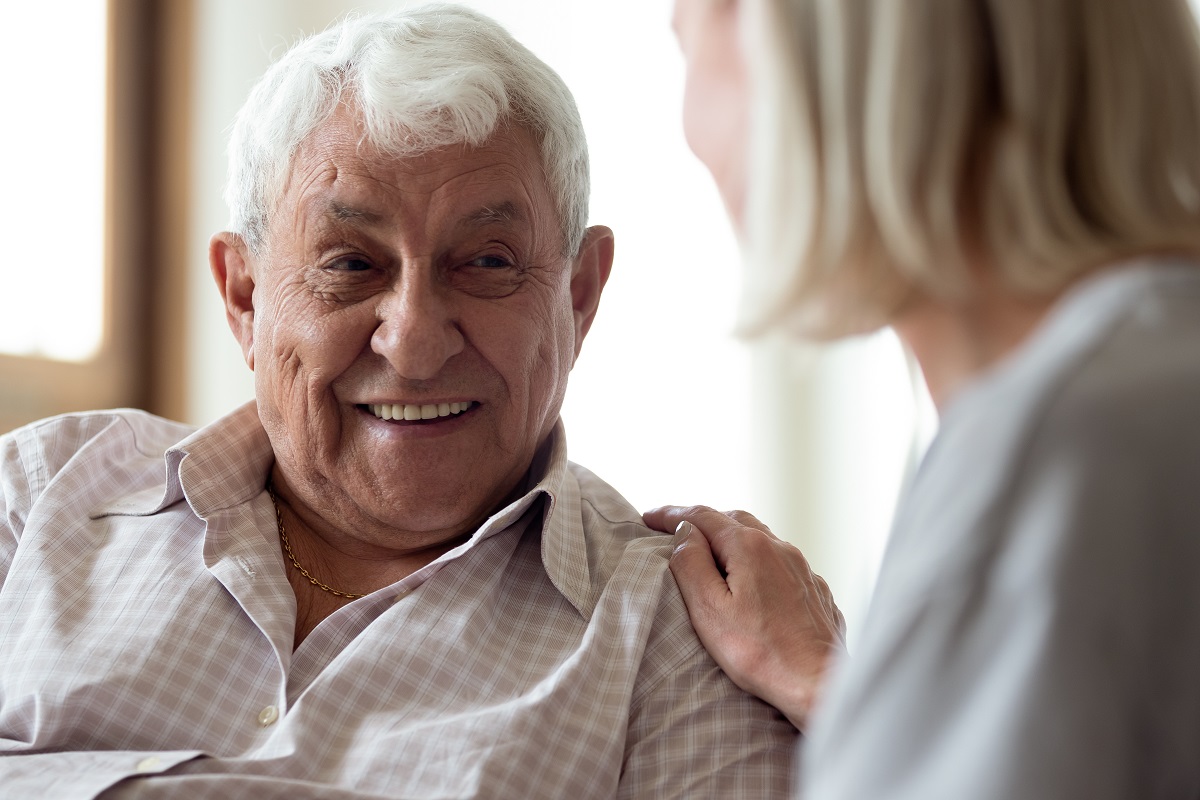And breathe… tips for keeping calm with dementia
Struggling with stress and agitation? Find out how these relaxation therapies can help a person living with dementia to feel calmer
Coming to terms with the fact that you have memory loss can be extremely difficult. Many people can become panicked and agitated when they realise they can’t remember something. Stress levels rise, they could become angry or frustrated, or simply withdraw from company altogether.
That’s why it’s so important to help a person with dementia feel calm and relaxed. This can be done through a range of activities, techniques and therapies. These include:
Breathing exercises
This is a good place to start for anyone who’s feeling anxious or stressed about their memory loss or dementia symptoms. If you start to notice that the person you care about is becoming panicked, doing some breathing exercises may help to calm them.
First, encourage them to sit comfortably with their hands on their stomach. As they take a breath in through their nose, ask them to feel their stomach and abdomen expand. Breathing in this way means you’re taking oxygen right into your lungs rather than taking short, shallow breaths that only reach the top of the lungs. Ask them to breathe in for a count of three, and out for a count of at least five, letting the air out slowly, and feeling their hand move back and forth each time they do it.
Doing this for 10 minutes a day or whenever they feel stressed can help to increase calmness.
Visualisation
Like breathing exercises, this can be useful if you just need a quick way to feel calm. Obviously, someone with dementia may struggle to remember a specific visualisation, so you may need to guide them through it. Visualisation has been found to reduce stress, improve mood and boost confidence.
Ask the person you’re caring for to close their eyes and imagine a place where they might feel relaxed and rested – maybe a quiet beach, a warm room at home, or a peaceful clearing in a forest.
Ask them to really focus on what they can see, the colours, the way the light is shining, the smells, and the sounds. Ask them to imagine what these sensations will feel like for them. Can they feel a soft breeze on their face or soft grains of sand between their toes? Ask them to notice how they feel emotionally – happy, warm and at peace.
Spend about five minutes helping them visualise this place. Then slowly encourage them to bring themselves back into the room, notice their surroundings and become aware of their body. Finally, ask them to open their eyes.
Mindfulness
This simply means becoming more aware of the present moment, and not worrying about what’s gone on in the past or what could happen in the future. It’s a good therapy for people with dementia because it’s all about being in the here and now, and not worrying if you can’t remember what happened yesterday.
A study from Northwestern University Feinberg School of Medicine found that mindfulness therapy could help people with dementia and their carers, particularly if they practiced it as a joint activity. Researchers saw lower depression scores and improved ratings on sleep quality and quality of life for both groups.
You can teach yourself how to be more mindful, but people also go on courses – some last a few weeks, others can be done in an hour or two – it just depends how comprehensive and detailed you want it to be.
Animal-assisted therapy
They say that dogs are man’s best friend, and when it comes to making you feel better, whether it’s a dog, cat, guinea pig or favourite fish, spending time with animals can be very relaxing. This has been recognised with animal-assisted therapy, which is where a specially trained animal (usually a dog or cat) is taken into hospitals or care homes to provide comfort and enjoyment for people. Just interacting with an animal, who has no judgement or opinion of someone with Alzheimer’s, can help to boost mood and encourage calmness.
The charity Pets as Therapy send people round different places with animals to provide comfort and joy and the results are very noticeable. Carers report reduced aggression, shouting and agitation after one of their visits.
Find out how pets can help to boost happiness in people with dementia.
Massage
Touch can be an immensely powerful therapy – just think how much comfort we get from hugging each other. That’s why massage can also be a useful therapy for someone with dementia.
There has been limited research into massage and dementia, but the work that has been done has been promising. Researchers in Canada conducted a three-day study on 57 Alzheimer’s patients at a facility in British Columbia. The patients were divided into three groups based on the amount of touching they were to get: twice-a-day massages; “non-nurturing” touch, and no touching at all. The caregiving staff, who were not told which patients were in which group, then rated the patients’ behaviour. Staff members found “touched” groups to be calmer.
Stopping every day to have a massage may not be the most convenient of activities, but even a simple hand and arm massage can be extremely soothing. Use natural aromatherapy oils or a scented body moisturiser and use long sweeping strokes along the arm and fingers.
Sensory rooms
Sometimes day centres and nursing homes will set up what is known as a sensory room. This is a room which has been decked out with lots of sensory gadgets, lighting and items. For example, a projector with special pictures beamed onto a wall, mirror balls, fibreoptic spray lights, music equipment, soft throws or cushions, bubble tubs and aromatherapy.
The idea is that this sensory stimulation can be extremely enjoyable for someone with dementia as it engages them, but doesn’t require lots of thinking abilities. Sensory rooms were first developed in the Netherlands in the 1970s. They were known as “snoezelen” formed from the Dutch “snuffelen” (to seek out, to explore) and “doezelen” (to doze, to snooze), but have become popular all over the world. Sensory rooms have been found to help reduce agitation in people with dementia.
Yoga and Tai Chi
Both of these activities can be extremely beneficial for people with dementia because they are very holistic – that is, they don’t just work the body, but they also help with the whole mind-body connection. They include a system of beliefs and ways of thinking that can be as good as many other therapies.
Yoga is not just a series of stretches and poses, it also teaches breathing techniques and mindfulness. Likewise, Tai Chi has a whole system of beliefs surrounding the way energy moves around the body, and the way you can move to help improve this, which can be very calming and effective for people with dementia.
Both yoga and tai chi are best learnt from a professional instructor. The good news is that there are lots of classes out there, including ones that are designed for specific groups of people such as those with limited mobility or for older people.
SHARE
Explore more



